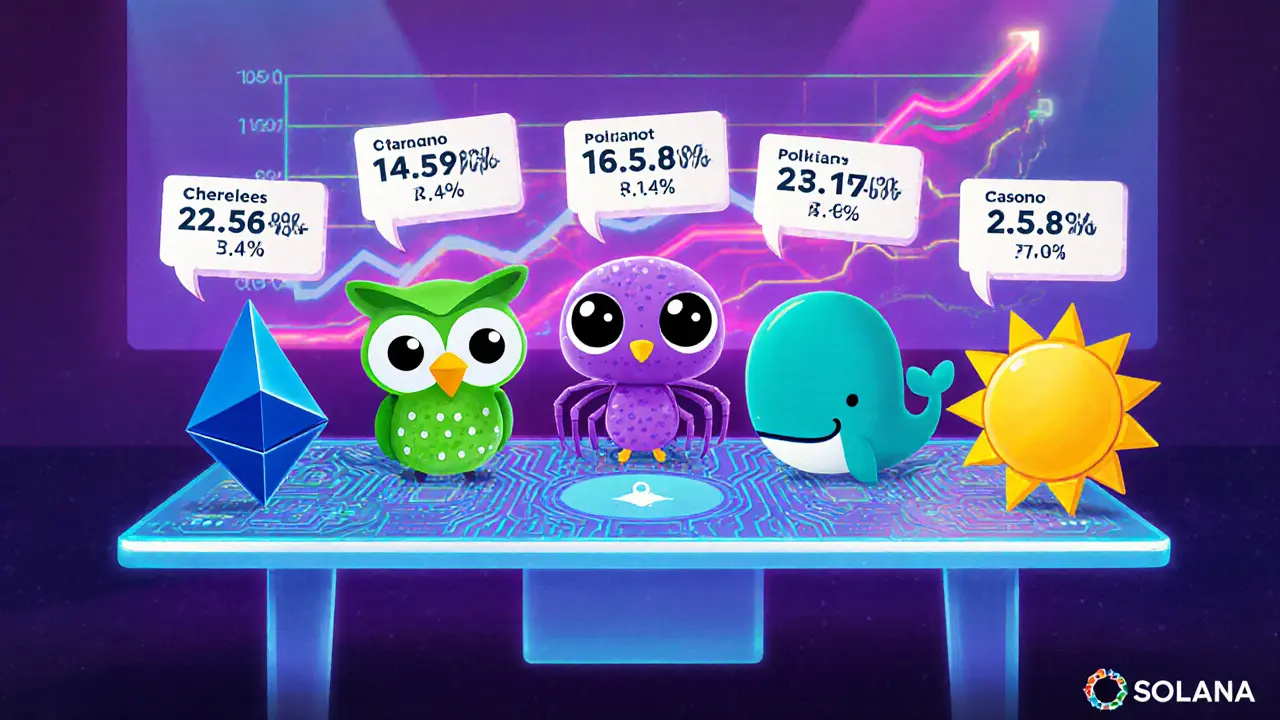Staking Earnings Calculator
Estimate Your Staking Returns
Calculate your potential earnings by entering your investment amount and selecting a network from the list.
Estimated Annual Returns
Enter your investment details to see your potential earnings
Ever wondered if you can turn your crypto holdings into a steady side‑income stream? Cryptocurrency staking earnings have become a hot topic as more investors look for passive ways to grow their portfolios without the heavy energy costs of mining. This guide breaks down what staking really pays, how the numbers differ across major networks, and what you need to watch out for before you lock up your tokens.
What Staking Actually Is
Staking is a process where crypto holders lock up a certain amount of a proof‑of‑stake (PoS) token to help secure the blockchain and validate transactions. In return, the network distributes new tokens as rewards. Unlike mining, there’s no expensive hardware-just a wallet or a validator node that stays online.
Why APR Varies So Much
Every PoS chain sets its own reward schedule, inflation rate, and validator requirements. That’s why you’ll see APRs ranging from under 3% on a giant like Ethereum the world’s second‑largest blockchain that switched to PoS in September 2022. to more than 25% on newer, high‑inflation networks such as Cosmos a modular ecosystem that rewards validators with ATOM tokens.. The key drivers are:
- Token inflation - more new coins mean higher nominal yields but also dilution.
- Network participation - more stakers share the same reward pool, lowering individual returns.
- Validator fees and slashing penalties - operational costs cut into net earnings.
- Liquidity & lock‑up periods - longer unbonding windows can affect the effective annualized return.
Top Staking Networks and Their 2025 APRs
| Network | APR (Annual % Rate) | Minimum Stake | Total Value Locked (TVL) |
|---|---|---|---|
| Ethereum | 2.48% | 32 ETH (~$102,400) | $17.8B |
| Cardano | 4.96% | 2 ADA (refundable fee) | 24.5B ADA |
| Polkadot | 15.31% | 350 DOT | 610.9M DOT |
| Cosmos | 25.17% | Variable (validator‑specific) | 222.7M ATOM |
| Solana | 7.58% | 0.01 SOL | 386.6M SOL |
| Tezos | 5.89% | 6,000 XTZ | 694.1M XTZ |
| Avalanche | 9.51% | 2,000 AVAX | 230.7M AVAX |
| Algorand | 7.20% | 1 ALGO | 1.41B ALGO |
| Near Protocol | 9.89% | Seat price (≈0.1 NEAR) | 514.4M NEAR |

How to Translate APR into Real Dollar Returns
The easiest way to gauge earnings is to apply the APR to the amount you plan to stake, then adjust for fees and token price change. Here’s a quick formula:
- Calculate gross reward: Stake×APR÷100.
- Subtract platform or validator fees (usually 5‑15%).
- Factor in token price movement - if the token drops 10%, your dollar return shrinks accordingly.
Example: Staking 100DOT at a 15.31% APR on a pool that takes 10% fees.
- Gross reward = 100×15.31÷100 = 15.31DOT.
- Net after fees = 15.31×0.90 = 13.78DOT.
- If DOT stays at $5, you earn $68.90 in a year. If it falls to $4, your profit drops to $55.12.
Repeating this calculation for each network lets you build a personalized earnings spreadsheet.
Net vs. Gross Returns - The Hidden Costs
Published APRs rarely reflect the actual money you walk away with. Three main deductions bite into earnings:
- Platform commissions: Centralized exchanges like Coinbase can keep 25‑35% of your reward, while dedicated staking services usually charge 10‑15%.
- Slashing penalties: If your validator goes offline or behaves maliciously, you can lose a portion of your stake. Recent data shows 12% of independent validators suffered slashing in 2024.
- Tax implications: In the U.S., staking rewards are treated as taxable income at the fair market value when received. In the EU, MiCA‑compliant platforms issue tax‑friendly statements, but you still must report gains.
After accounting for an average 12% fee + 2% slashing risk, a 15% APR often turns into around 12% net yield.
Risk Profile: Low‑Risk vs. High‑Reward Networks
Think of staking tiers like this:
- Low‑risk (2‑5% APR): Ethereum, Cardano - massive market caps, stable token prices, but lower yields.
- Medium‑risk (5‑12% APR): Solana, Tezos, Avalanche - decent returns, moderate price volatility, relatively quick unbonding.
- High‑risk / high‑reward (12%+ APR): Polkadot, Cosmos - attractive yields, higher inflation, and sometimes longer lock‑up periods.
Your personal risk tolerance should dictate how much you allocate to each bucket.

Practical Steps to Start Staking Today
Here’s a streamlined roadmap for beginners:
- Choose a network. Look at APR, minimum stake, and your comfort with technical setup.
- Select a method. Options are:
- Exchange‑based staking (instant, low effort).
- Non‑custodial wallet delegation (e.g., via Ledger + a staking pool).
- Running your own validator (high reward, high upkeep).
- Transfer the tokens. Send the exact amount needed to the staking address or pool.
- Activate staking. Follow the platform’s UI - usually a single “Stake” button.
- Monitor rewards and fees. Most dashboards show earned tokens, pending withdrawals, and fee breakdown.
- Reinvest or withdraw. Re‑staking rewards can boost compounding returns by ~22% over 12months, according to Milk Road’s 2025 study.
All of this can be done in under 30minutes if you go the exchange route.
Common Pitfalls and How to Avoid Them
Even seasoned stakers run into avoidable mistakes. Keep an eye on the following:
- Ignoring lock‑up periods. Ethereum still requires a 2‑3 week unbonding window, which can be painful if the market crashes.
- Overlooking validator uptime. A single downtime event can trigger a slash that wipes out 5‑10% of your stake.
- Failing to factor tax. In the U.S., each reward distribution is a taxable event, so you’ll need good record‑keeping.
- Putting all eggs in one basket. Diversify across at least three networks with different risk levels to smooth volatility.
- Choosing high‑fee pools. A 15% fee can turn a 9% APR into a net loss. Always compare pool fee structures before delegating.
Future Outlook: What 2026 Might Look Like
Staking isn’t static. Upcoming upgrades and regulatory shifts will reshape earnings:
- Ethereum’s Prague upgrade aims to lower the minimum stake to 1ETH, potentially tripling participant numbers.
- As more blockchains adopt PoS, competition for validator slots will increase, nudging average APRs toward the 3‑7% range for major assets.
- Institutional players are entering the space, driving higher TVL but also stricter compliance requirements.
- Regulators in the U.S. and EU are clarifying tax treatment, which could either raise reporting costs or provide clearer guidance that encourages wider adoption.
In short, expect returns to moderate over time, but the sheer variety of networks will keep opportunities alive for both conservative and aggressive investors.
Frequently Asked Questions
What is the realistic net APR after fees for popular staking networks?
After accounting for platform commissions (10‑15% on most delegations) and occasional slashing, net APRs typically look like this: Ethereum≈2%, Cardano≈4%, Solana≈6‑7%, Polkadot≈12‑13%, Cosmos≈20‑22%.
Can I stake with as little as $10?
Yes. Networks like Algorand (1ALGO) or Solana (0.01SOL) let you start with a few dollars. The key is to use a low‑fee pool or a non‑custodial wallet that doesn’t charge a flat commission.
How often are staking rewards paid?
Most networks distribute rewards every few days to a week. Exchanges often batch them monthly, while validator‑run pools may auto‑compound daily.
Is staking taxable in the United States?
Yes. The IRS treats each reward distribution as ordinary income at its fair market value on the day you receive it. Capital gains tax applies when you later sell the tokens.
What’s the biggest risk of staking?
Beyond token price volatility, the biggest operational risk is slashing - losing part of your stake because your validator missed blocks or acted maliciously. Using reputable pools and monitoring uptime mitigates this.
Manas Patil
October 13, 2025 AT 02:26Staking can net you decent passive returns if you pick the right chain.
Melanie Birt
October 24, 2025 AT 07:58When you allocate capital into a PoS network, the APR compounds automatically, so you don't have to manage daily trades 😃
Make sure to factor in validator fees and any token price volatility when running the calculator.
The ETH 2.48% APR is modest but low-risk, whereas Cosmos at 25.17% offers higher yields at increased exposure.
Diversifying across several chains can smooth out reward variance and protect against network-specific slashes.
Also remember to check the minimum staking thresholds; some protocols lock you out if you’re under the required amount.
Sanjay Lago
November 4, 2025 AT 13:30Yo fam, if u wanna earn while you chill, pick a network with decent APR and low fees.
Cardano’s 4.96% is pretty chill and the fees are tiny, so your net profit stays nice.
Just watch out for the token price swing, that can flip your gains upside down.
And don’t forget to keep your validator nodes updated, otherwise you might get slashed.
Nathan Van Myall
November 15, 2025 AT 19:02Adding staking income to a diversified portfolio can improve the overall risk‑adjusted return.
Focus on networks with transparent governance and solid community support to reduce operational risk.
The fee percentage you input should reflect both network fees and any custodial service charges.
Annie McCullough
November 27, 2025 AT 00:35Sure the high APRs look shiny but they come with hidden risk like slashing and inflation
Take the glossy numbers with a grain of salt and read the fine print on validator uptime requirements